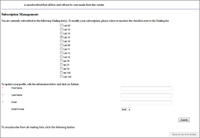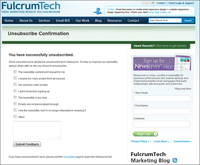Email Marketing Best Practices – Unsubscribing Do’s and Dont’s
What impression do you leave with subscribers who choose to opt out from your email list? Keep in mind that just because they want to unsubscribe, doesn’t mean they no longer want to be a customer. So if your unsubscribe process is confusing, takes too long, and causes frustration, you’ll leave prospects and customers with negative feelings about your organization. Plus, they’ll be much more likely to mark your email as spam, which can negatively impact your deliverability and, ultimately, return on investment (ROI).
Here we share some quick unsubscribe do’s and don’ts to help you comply with CAN-SPAM requirements and avoid annoying subscribers during the unsubscribe process. Plus, be sure to check out our previous NewsLever feature on the topic: “What Can an Unsubscribe Landing Page Do for Your Email Program?”
- Do make the unsubscribe button obvious. Too often the unsubscribe button is lost in a long list of links or displayed in tiny, translucent type.
- Do say it like it is — “unsubscribe.” Ambiguous terms such as “edit,” “manage,” and “delete” are frequently used to describe the opt-out process.
-
Don’t make unsubscribing a complicated process. A one-click unsubscribe process is a good practice: Subscribers click the unsubscribe link, which takes them to an unsubscribe landing page, where they click one link to unsubscribe. Don’t make them log in or confirm their email address to complete the process.
- Do send them to a branded landing page. Let subscribers know right away that they are in the right place by including a company name and logo on your unsubscribe landing page. It’s surprising how many unsubscribe landing pages have no corporate identity.
- Do provide options on the unsubscribe landing page. Perhaps subscribers don’t want to completely sever their relationship with your organization. They may just want to reduce the number of emails in their inboxes. So in addition to giving them the option to fully unsubscribe from your email lists, let them choose the publications they’d like to unsubscribe from and/or the frequency in which they want to receive emails from you. Plus, give them the option to simply update their email address.
- Do ask why. Take the opportunity to find out why subscribers want to unsubscribe, after they do so. And make it easy for them to answer by including only a few multiple-choice questions and a text field. With this information, you may get some valuable tips on ways to improve your email-marketing efforts in the future.
- Don’t burn your bridges. Because people who unsubscribe may remain customers and/or wish to subscribe again at a later date, be sure to leave them with a positive impression of your organization. So thank them for their interest and let them know they’ll be missed.
Of course, you should always focus your email-marketing efforts on preventing subscribers from getting the urge to unsubscribe. Some important ways to do that include sending targeted, relevant content, offering a preference center where subscribers can control the frequency and type of content they receive, and setting expectations from the start by letting people know what types of email you’ll be sending and how often.
Do you have any good (or bad) examples of unsubscribe experiences? Please share them with us!

